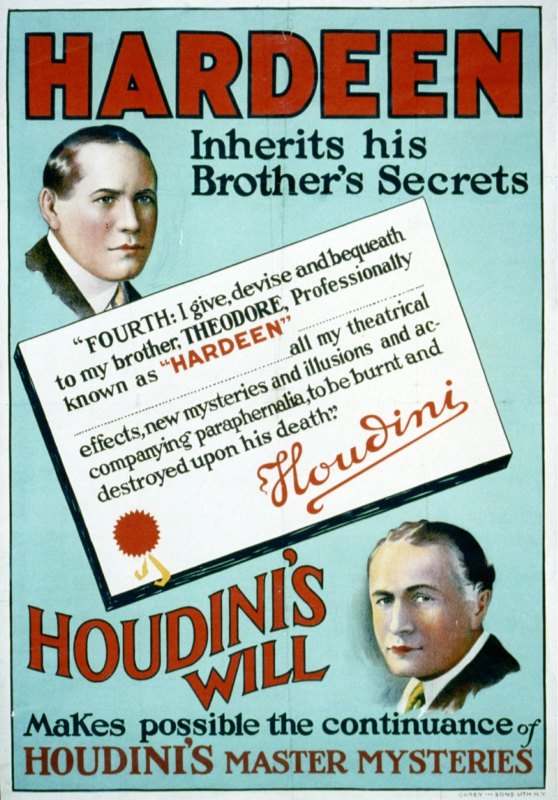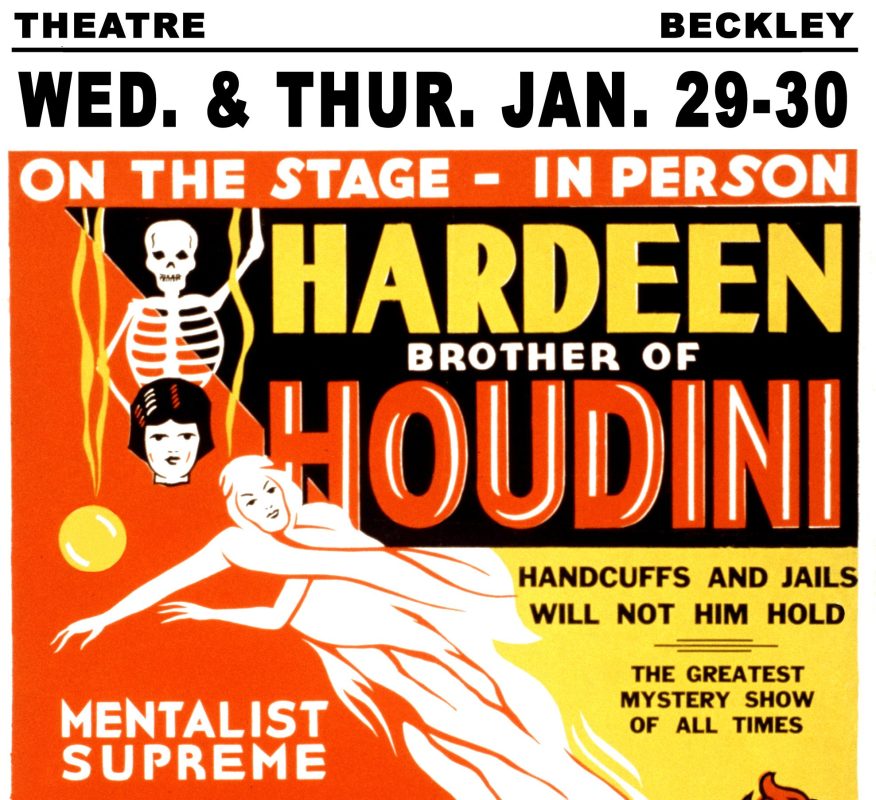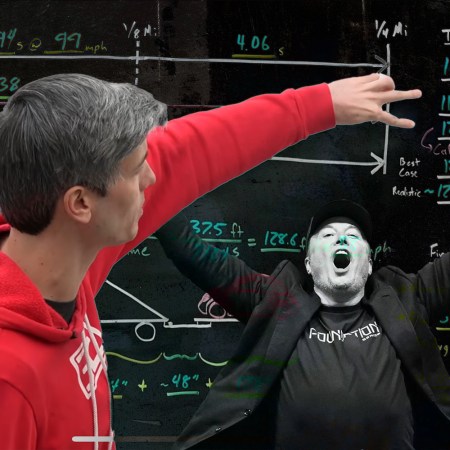It doesn’t take a magician to conjure Harry Houdini’s place in films and TV series. Productions range from 1953’s Houdini with Tony Curtis (see below) to Houdini & Doyle, a 2016 project in which he teams up with Sherlock Holmes creator Sir Arthur Conan Doyle to solve particularly mysterious murders.
He has been portrayed by an Oscar winner (Adrien Brody in 2014’s TV series Houdini) and a Reservoir Dog (Harvey Keitel in 1997’s FairyTale: A True Story—Doyle also appears in this one, played by Peter O’Toole).
But to feel Houdini’s full impact, attempt to track how often he gets invoked in pop culture in general. Harry has inspired songs including Walter Brennan’s “Houdini” in 1962, Kate Bush’s “Houdini” in 1982, Foster the People’s “Houdini” in 2012, and Travis Scott’s “Houdini” in 2018. Not to mention the New York rap group Whodini put out an album in 1984 titled Escape. (Pitchfork named it one of the 200 Best of the ’80s.)
Then there’s Houdini’s little brother, Hardeen. Unless you’re a Boardwalk Empire fanatic, you probably don’t know that name. (Even if you are a Boardwalk obsessive, you may have forgotten—Hardeen appears in the episode “Paris Green.”) Hardeen is sometimes a minor character in works about Houdini, though often he gets left out entirely. If you knew Houdini purely through television, you might conclude his closest male companion was Doyle. (After all, Sir Arthur also pops up in 1998’s Houdini and 1976’s The Great Houdini.)
It is impossible to relate the story of Hardeen without Houdini—his brother is his great claim to fame. Yet Hardeen helped ensure his brother’s name stayed alive, long after Harry passed on, long after Hardeen himself faded from prominence.
As Harry’s birthday — March 24 — approaches, this is a prime time to see how his little brother kept a family business going (and kept the Houdini name in the headlines) for nearly two decades after Harry made his final escape.
From Budapest to Showbiz
The Weisz/Houdini brothers were born in Budapest, Hungary: Erich (Harry) on March 24, 1874 and younger brother Ferenc Dezso on March 4, 1876. (The family had a total of seven children.) Their father was a rabbi who brought the family to Appleton, Wisconsin. Harry Houdini apparently did not look back on the years spent there fondly, quipping, “The greatest escape I ever made was when I left Appleton, Wisconsin.”
By age 20, Erich had moved to New York, married the woman who would be his wife/assistant for the rest of his life (Wilhelmina Beatrice Rahner, who went by “Bess”), and dubbed himself “Harry Houdini.”
“Houdini” came from Jean Eugene Robert-Houdin, a French illusionist known as the “father of modern magic.” Robert-Houdin achieved a level of fame comparable to what Harry would later attain—after all, he died nearly three years before Harry was even born yet his name still held strong. Even today, a museum dubbed the House of Magic salutes the Robert-Houdin legacy in Blois, France.
Finding limited success as a magician, Houdini drew attention when he embraced stunts over tricks. To this day, “escape artist” summons to mind one word: “Houdini.” By 1899, he was touring leading vaudeville venues, first in the United States and then in Europe. By 1909, Houdini’s success was such he bought his own plane. He also started both magic and film companies.
A master of escaping from handcuffs—he was dubbed the “King of Handcuffs“—Houdini continued to increase the complexity of his act. He moved up to water-filled tanks and nailed-shut packing crates, reasoning: “The easiest way to attract a crowd is to let it be known that at a given time and a given place someone is going to attempt something that in the event of failure will mean sudden death.”
Houdini became particularly celebrated for his Water Torture Cell (often called the Chinese Water Torture Cell), which you can see below.
While understandably protective of his professional secrets, Houdini was quick to note his feats weren’t the result of the supernatural. Houdini desperately wanted to believe in spiritualism in the hope that he would be able to speak with his late mother. Invariably, however, he encountered charlatans, ones with tricks he cracked. Spiritualism would make Sir Arthur Conan Doyle his friend—Doyle was a true believer in communication with the afterworld—and then permanently damage their relationship. The pair met in 1920 and, while spending time together in 1922, Houdini agreed to let Doyle’s wife perform a seance to communicate with his mother.
Houdini was heartbroken to recognize a scam and a poorly executed one at that. Jean Leckie Doyle relayed that Harry’s late mother was making the sign of the cross… an unlikely maneuver for the wife of a rabbi. Houdini even wrote books to try to ensure people weren’t sucked in by supernatural scams, including Miracle Mongers and Their Methods and The Unmasking of Robert-Houdin, a critique of his own namesake.
Houdini toured his entire life. On Halloween of 1926, he died at 52 in Detroit of peritonitis from a ruptured appendix. The reported circumstances were bizarre. Houdini was apparently punched at least once and possibly multiple times by a college student curious about the reported strength of Houdini’s stomach muscles. There are even rumors of a poisoning. Nevertheless, it still appears his ultimate cause of death was likely innocuous—Houdini failed to seek treatment for his appendix in a timely manner. (He most decidedly did not die because of a trick gone wrong, legend and 1953 film aside.)
Houdini did not have children, meaning there were no offspring to carry on his craft. While he was intrigued by cinema and made a handful of films, it certainly wasn’t a medium he conquered. The most celebrated footage of him may be 1919’s silent adventure film The Grim Game, which was lost for decades until being TCM reintroduced a restored version in 2015.
There was only one man who could keep the Houdini name and legacy alive.
Here’s Hardeen
Hardeen (also known as Theodore Hardeen or “Dash”) actually started out performing with Harry. Together, they were known as “The Brothers Houdini.” It’s been stated they split largely because, in the wake of Harry’s marriage, it was felt the act could only support two people, not three.
Thus began an occasional “rivalry” as the two sought customers. In actuality, the brothers remained close. Hardeen is credited with at least one major innovation, with his performing of public escapes from a straitjacket as the audience watched. (Harry would later also perform the feat.)
Harry Houdini, however, was the one who shot to fame and forever the main attraction. Houdini was uniquely well built for escapes, being small (his height has been reported anywhere from 5’5″ to 5’7″) but intensely powerful. He had a knack for brilliant publicity stunts—witness his escape from the cell of Charles Guiteau, the man who assassinated President Garfield in 1881. The gap between the brothers is even reflected in their chosen names—“Harry Houdini” is instantly memorable, “Theodore Hardeen” is decidedly not. (Doubly surprising because Harry apparently personally picked it for his brother.)
Hardeen seemed content in the shadows. He announced his retirement from the stage in 1917, stating he wanted to be able to raise his sons. (He told the Oakland Tribune: “When a boy is old enough to go to school he needs a father to see that he’s started right.”) Even then, he remained close to his brother, running Harry’s Film Developing Corporation.
Then Harry Houdini died and suddenly Hardeen found himself in the spotlight, yet even then his brother was right there with him.
Where There’s a Will…
If Hardeen had to sell himself in a single sentence, it have might been: “Since you can’t watch Harry Houdini, why not look at me?”

Even in death, Houdini outshone Hardeen. As the poster above notes, “HARDEEN Inherits his Brother’s Secrets; HOUDINI’s WILL Makes possible the continuance of HOUDINI’S MASTER MYSTERIES.” Indeed, it makes a point of explicitly spelling out the inheritance: “FOURTH: I give, devise and bequeath to my brother, THEODORE, Professionally known as ‘HARDEEN,’ all my theatrical effects, new mysteries and illusions and accompanying paraphernalia, to be burnt and destroyed upon his death. Houdini.”
In total, the ad includes the name “Houdini” three times… and “Hardeen” twice.
Yet it’s worth remembering that, while the Houdini name certainly drew attention, someone still had to go out and get the job done. And that’s what Hardeen did, witness this film footage:
Hardeen kept the act going until 1945. When he passed at age 69, the New York Times called him an “Illusionist, Escape Artist, a Founder of Magician’s Guild.” Of course, Harry was right there, as the first sentence of the obit read: “Theodore Hardeen, a brother of the late Harry Houdini, illusionist and a prominent magician in his own right, died yesterday in the Doctors Hospital.” The Times noted Hardeen continued performing right up to two weeks before his death.
Unquestionably, Hardeen’s connection to Houdini was good to him—he got a lifelong career out of it. But it also benefited his brother.
Keeping the Name Alive
In that Boardwalk Empire episode, we see Hardeen perform his act; he later chats with Nucky and other attendees. Considering that relatively brief screen time, there are an impressive number of unflattering comparisons made to his brother. In general, there’s a sense that people enjoy seeing Hardeen but boy, wouldn’t it be something to have Harry. (I went to grad school with Remy Auberjonois, who played Hardeen on Boardwalk Empire. When contacted to see if there were any discoveries he made during the role, Auberjonois reported the other Houdini largely remained out of reach for him too: “I’m afraid my insights on Hardeen are limited.”)
Harry Houdini died in 1926. The footage we have of him is black and white, silent, some of it lost to history until recently, some of it apparently lost altogether. Would his name have remained so ubiquitous if this was the only record we had of him? Houdini wasn’t the only famous magician of his era—don’t expect a series devoted to Harry Kellar (1849-1922) or “Master Magician” Howard Thurston (1869-1936) any time soon.
But Houdini had Hardeen. Hardeen ensured that the Houdini name continued to connect with audiences, even after Harry (and his competitors) died. Perhaps most impressively, Hardeen somehow gave audiences the sense that his act was worth watching—after all, he kept it going nearly 20 years after Harry’s demise—but that they had missed something invaluable by not witnessing Houdini do it personally.
Of course, Hardeen eventually passed on himself. But within a decade, an event occurred to ensure Harry would remain a household name. After decades in development hell, at last a Harry Houdini biopic reached the screen. Rotten Tomatoes describes 1953’s Houdini as “highly fanciful but immensely entertaining.”
Among the omissions from Harry Houdini’s actual life: Hardeen. But the film served its main purpose: It kept people interested in Harry. (Indeed, John Cox, curator of the site Wild About Harry: Where Houdini Lives, credits the film with triggering his lifelong obsession.) And Hardeen helped keep people interested in Harry long enough for it finally to get made. With the result that today Houdini is a genuinely iconic figure, inspiring both exhibitions at New York’s Jewish Museum and TV series where he fights potentially supernatural crimes. Meaning Hardeen may not have been his brother’s equal as an escape artist, but he shall always be one of the all-time great baby brothers.
This article was featured in the InsideHook newsletter. Sign up now.























